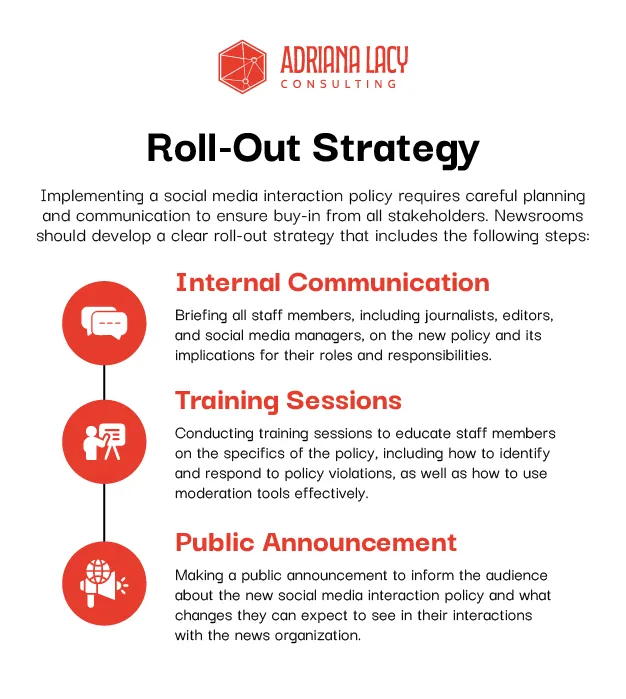Introduction
Objectives
In the fast-evolving landscape of journalism, the digital realm has become inseparable from the dissemination of news. Social media platforms offer unparalleled opportunities for engagement, allowing newsrooms to interact directly with their audience in real-time. However, with this newfound accessibility comes a pressing need for news organizations to establish clear guidelines governing these interactions.
This white paper aims to provide comprehensive guidance to newsrooms seeking to develop or refine their social media interaction policies. By outlining best practices and offering actionable insights, we aspire to assist editorial teams, social media managers, and administrative staff in navigating the complex terrain of online engagement.
The Need for a Policy
The proliferation of social media has undeniably revolutionized the way news is consumed, shared, and discussed. However, this digital revolution has also brought to light a darker side: the rampant spread of online harassment and abuse directed at journalists. From targeted attacks based on gender identity to vitriolic comments fueled by political ideologies, the safety and well-being of journalists in digital spaces are increasingly under threat.
In response to this growing concern, newsrooms must proactively safeguard their staff while upholding the principles of free speech and open discourse. A robust social media interaction policy serves as a crucial tool in achieving this delicate balance, providing a framework for managing interactions in a manner that fosters constructive engagement while mitigating the risks of harm and harassment.
Context
Recent years have witnessed a disturbing surge in online harassment targeting journalists, with incidents ranging from cyberbullying to outright threats of violence. This toxic environment not only jeopardizes the mental and emotional well-being of individual journalists but also undermines the integrity and credibility of the journalistic profession as a whole.
Moreover, the nature of online harassment has evolved to include increasingly sophisticated forms of targeted attacks, such as transphobic or antisemitic comments. These insidious forms of abuse not only seek to intimidate and silence journalists but also perpetuate harmful stereotypes and prejudices within society at large.
In light of these pressing challenges, the need for newsrooms to develop comprehensive social media interaction policies has never been more urgent. By establishing clear guidelines and protocols for navigating the complexities of online engagement, news organizations can empower their staff to participate in digital discourse with confidence and integrity.
.webp)
Understanding the Need
The Role of Social Media in Journalism
Social media platforms have emerged as indispensable tools for journalists, offering unparalleled opportunities for real-time communication, audience engagement, and content distribution. From breaking news updates to behind-the-scenes insights, social media enables newsrooms to connect directly with their audience in ways that were previously unimaginable.
However, the rapid proliferation of social media has also introduced new challenges and complexities for journalists. The instantaneous nature of online communication means that news organizations must navigate a constant stream of information, opinions, and feedback, often in real-time. This dynamic environment requires careful consideration and strategic planning to ensure that journalists can effectively leverage social media while mitigating potential risks and pitfalls.
Specific Issues Faced by Journalists
Despite the myriad benefits of social media, journalists are increasingly confronted with a host of negative interactions that can have profound implications for their professional and personal well-being. From trolling and harassment to outright threats of violence, the digital landscape presents journalists with a range of challenges that must be addressed.
One of the most pervasive forms of online harassment targeting journalists is the proliferation of hate speech and personal attacks. Whether motivated by ideological differences, political biases, or personal animosities, these malicious comments can have a chilling effect on journalistic integrity and public discourse. Moreover, the anonymity afforded by social media often emboldens perpetrators to engage in behavior that they would never consider in a face-to-face interaction.
Case Examples
To illustrate the severity and impact of online harassment on journalists, consider the following case examples:
- Targeted Attacks: Journalists who cover sensitive or controversial topics, such as politics, religion, or social justice issues, are often subjected to coordinated campaigns of harassment and abuse. These attacks may include doxxing (the unauthorized release of personal information), threats of violence, or smear campaigns aimed at discrediting the journalist's work.
- Gender-Based Harassment: Female journalists, in particular, are disproportionately targeted with gender-based harassment and misogyny. From sexist remarks and sexualized threats to attempts to undermine their professional credibility, women in journalism face a barrage of online abuse that can have profound psychological and emotional consequences.
- Racial and Ethnic Discrimination: Journalists from marginalized communities are frequently subjected to racist and xenophobic attacks on social media. These attacks not only seek to silence the voices of minority journalists but also perpetuate harmful stereotypes and biases within the broader media landscape.
Legal and Ethical Framework
Overview of Legal Considerations
Defamation: News organizations must be vigilant in ensuring that their social media interactions do not inadvertently defame individuals or organizations. Defamation occurs when false statements are made that harm the reputation of another person or entity. As such, journalists should exercise caution when sharing information on social media and ensure that statements are accurate and based on reliable sources.
Harassment: Social media platforms have become breeding grounds for harassment and abuse, with journalists often bearing the brunt of online vitriol. Newsrooms have a duty to protect their staff from harassment and must take proactive measures to address any instances of abusive behavior directed at journalists. This may include implementing moderation policies, reporting abusive users to platform administrators, and, if necessary, seeking legal recourse against perpetrators.
Free Speech Boundaries: While freedom of speech is a cornerstone of democratic society, it is not without limits. Journalists must be cognizant of the boundaries of free speech and refrain from engaging in speech that incites violence, promotes hatred, or violates the rights of others. By adhering to ethical standards and legal guidelines, newsrooms can ensure that their social media interactions are conducted in a manner that respects the rights and dignity of all individuals.
Ethical Journalism and Moderation
In addition to legal considerations, newsrooms must also adhere to ethical standards in their social media interactions. Ethical journalism requires a commitment to truth, accuracy, fairness, and transparency, principles that should guide journalists' conduct both online and offline.
Balancing Open Dialogue with Protection: While social media platforms offer opportunities for open dialogue and engagement, they also present risks that must be managed responsibly. Newsrooms must strike a delicate balance between fostering robust discussion and protecting their staff from harm.
Reference to Ethical Guidelines: Media oversight organizations, such as the Society of Professional Journalists (SPJ) and the Ethical Journalism Network (EJN), provide valuable resources and guidelines for ethical journalism in the digital age. Newsrooms should familiarize themselves with these ethical principles and incorporate them into their social media interaction policies.
Crafting Your Policy
Setting the Boundaries
The cornerstone of an effective social media interaction policy lies in clearly defining acceptable behavior and setting boundaries for online engagement. Newsrooms must establish clear guidelines outlining the types of interactions that are deemed unacceptable, including but not limited to hate speech, personal attacks, harassment, and the dissemination of false information.
Procedures for Moderation
In addition to defining unacceptable behavior, newsrooms must establish procedures for moderating social media interactions and enforcing policy violations. This may include implementing a tiered system of responses, such as issuing warnings for first-time offenders, imposing temporary mutes or bans for repeated violations, and employing permanent blocks for egregious behavior.
Transparency and Accountability
Transparency is paramount in maintaining the trust and credibility of news organizations in the digital age. As such, newsrooms should strive to be transparent in their moderation practices, clearly communicating the rationale behind their decisions and the consequences of policy violations to their audience.
Implementing the Policy
Roll-out Strategy
Implementing a social media interaction policy requires careful planning and communication to ensure buy-in from all stakeholders. Newsrooms should develop a clear roll-out strategy that includes the following steps:
- Internal Communication: Briefing all staff members, including journalists, editors, and social media managers, on the new policy and its implications for their roles and responsibilities.
- Training Sessions: Conducting training sessions to educate staff members on the specifics of the policy, including how to identify and respond to policy violations, as well as how to use moderation tools effectively.
- Public Announcement: Making a public announcement to inform the audience about the new social media interaction policy and what changes they can expect to see in their interactions with the news organization.

Training and Support
In addition to initial training sessions, newsrooms should provide ongoing support and resources to help staff members navigate the challenges of social media moderation:
- Regular Updates: Providing regular updates and reminders about the policy and any changes or updates that have been made.
- Access to Resources: Offering access to resources and support networks, such as mental health services or legal counsel, for staff members who experience harassment or abuse on social media.
- Peer Support Networks: Facilitating the formation of peer support networks or discussion groups where staff members can share experiences and best practices for managing social media interactions.
Integrating with Existing Policies
A social media interaction policy should complement and align with existing policies and guidelines within the newsroom:
- Editorial Guidelines: Ensuring that the social media interaction policy is consistent with the news organization's editorial standards and guidelines.
- Code of Conduct: Integrating the social media interaction policy with the newsroom's broader code of conduct or ethics policy.
- Legal Considerations: Coordinating with legal counsel to ensure that the policy complies with relevant laws and regulations governing social media interactions.
Monitoring and Evaluation
Setting Up Mechanisms for Monitoring
Monitoring the effectiveness of the social media interaction policy is essential for ensuring its ongoing relevance and efficacy. Newsrooms should establish robust mechanisms for tracking key metrics related to online interactions, such as the frequency and nature of policy violations, audience engagement levels, and staff satisfaction with moderation practices.
Feedback Loops
Creating feedback loops is crucial for gathering insights and perspectives from all stakeholders involved in the implementation of the social media interaction policy. Feedback mechanisms may include surveys, focus groups, or one-on-one interviews with key stakeholders.
Regular Reviews
In addition to ongoing monitoring and feedback collection, newsrooms should conduct regular reviews of the social media interaction policy to evaluate its effectiveness and identify opportunities for enhancement. These reviews should be conducted at predetermined intervals, taking into account any changes in the digital landscape, emerging trends, or feedback received since the policy's implementation.
In an era defined by unprecedented connectivity and digital engagement, social media has emerged as a powerful tool for newsrooms to disseminate information, foster dialogue, and build community. However, alongside its myriad benefits, social media also presents significant challenges, particularly concerning the safety and well-being of journalists in online spaces.
Through this white paper, we have explored the importance of developing a robust social media interaction policy, delving into the legal, ethical, and practical considerations that inform its creation. From setting clear boundaries to implementing monitoring and evaluation mechanisms, we have outlined a comprehensive framework for newsrooms to craft policies that prioritize the protection of journalists while upholding the principles of free speech and open dialogue.
As news organizations embark on the journey of policy development and implementation, it is imperative to recognize that the landscape of social media is ever-evolving. Therefore, we encourage ongoing engagement, collaboration, and adaptation within the journalistic community to address emerging challenges and seize new opportunities in the digital age.
.webp)
Resources
Resources on Legal and Ethical Considerations
- "Social Media Law: A Handbook of Cases and Use" by Daxton R. Stewart
- "The Ethical Journalist: Making Responsible Decisions in the Digital Age" by Gene Foreman
- Online News Association (ONA) Ethics Code
Contact Information for Expert Advice on Policy Development
- Society of Professional Journalists (SPJ)
- Media Law Resource Center (MLRC)
- Digital Content Next (DCN)
Moderation Tools
- Social Media Management Platforms: Platforms like Hootsuite, Sprout Social, and Buffer offer features for scheduling posts, monitoring mentions and comments, and analyzing engagement metrics across multiple social media channels.
- Content Filtering and Moderation Software: Tools like Brandwatch, Talkwalker, and Sprinklr use artificial intelligence and machine learning algorithms to automatically filter and moderate social media content based on predefined criteria, such as keywords, sentiment analysis, and user behavior patterns.
- Community Management Tools: Platforms like Disqus, Facebook's Page Moderation, and Twitter's TweetDeck provide tools for managing comments, replies, and direct messages on social media platforms, including features for filtering spam, blocking users, and hiding inappropriate content.
- Analytics Dashboards: Social media platforms themselves, such as Facebook Insights, Twitter Analytics, and Instagram Insights, offer built-in analytics dashboards that allow newsrooms to track key metrics related to audience engagement, reach, and interactions, helping them to monitor the effectiveness of their social media strategies and identify areas for improvement.
Appendix
Sample Codes of Conduct from Other Newsrooms
FAQs
1. What is the purpose of a social media interaction policy for newsrooms?
A social media interaction policy establishes guidelines and procedures for journalists and staff to engage with audiences on social media platforms in a professional, respectful, and responsible manner.
2. What types of behavior are considered unacceptable under a social media interaction policy?
Unacceptable behavior may include harassment, hate speech, defamation, spreading misinformation, personal attacks, and any other conduct that violates the rights or dignity of others.
3. How should newsrooms handle instances of online harassment directed at their staff?
Newsrooms should have clear procedures in place for reporting and addressing incidents of online harassment, including providing support to affected staff members, investigating complaints, and taking appropriate action against perpetrators.
4. What are the consequences for violating a social media interaction policy?
Consequences for policy violations may vary depending on the severity of the infraction and the organization's policies. They may include warnings, temporary suspensions, permanent bans, or disciplinary action.
5. How can newsrooms balance freedom of expression with the need to maintain a safe and respectful online environment?
Newsrooms can strike a balance between freedom of expression and responsible moderation by establishing clear guidelines, enforcing policies consistently, and fostering open dialogue while protecting individuals from harm.
6. How should newsrooms respond to criticism or negative feedback on social media?
Newsrooms should respond to criticism or negative feedback constructively and professionally, addressing valid concerns while avoiding engaging with hostile or abusive individuals.
7. What measures can newsrooms take to prevent the spread of misinformation on social media?
Newsrooms can combat misinformation by prioritizing accuracy and fact-checking, providing credible sources, labeling disputed content, and educating audiences on how to identify and verify trustworthy information.
8. How often should a social media interaction policy be reviewed and updated?
Social media interaction policies should be reviewed regularly, ideally at least once a year, to ensure they remain relevant and effective in addressing emerging challenges and evolving best practices.
9. What resources are available to help newsrooms develop or refine their social media interaction policies?
Newsrooms can access resources such as industry guidelines, legal advice, best practice examples, and training materials provided by professional organizations, media associations, and legal experts specializing in media law.
10. How can newsrooms promote transparency and accountability in their social media moderation practices?
Newsrooms can promote transparency and accountability by publicly documenting moderation actions, providing explanations for decisions, soliciting feedback from the community, and regularly reviewing and updating their policies based on lessons learned and feedback received.
Are you looking for support in crafting your social media policy? Email info@adrianalacyconsulting.com for help.









